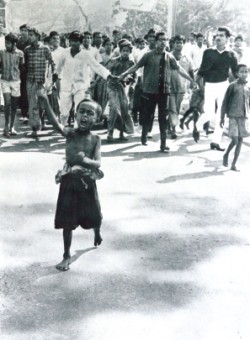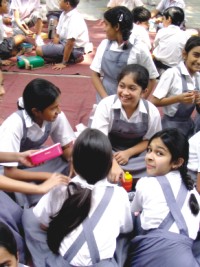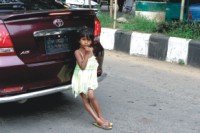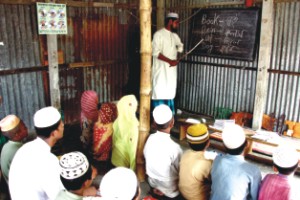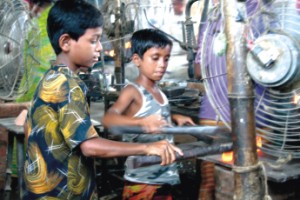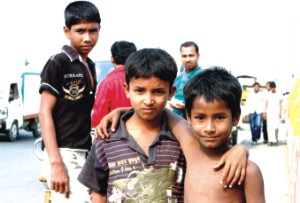| Home - Back Issues - The Team - Contact Us |
 |
| Volume 10 |Issue 17 | April 29, 2011 | |
|
|
Cover Story
We, the people of Bangladesh, are truly unique in many ways. We manage to exist in a chaotic place where everyday is a struggle, what with the political instability, sky high crime rates, lack of law and order, corruption, natural disasters, pollution, lack of basic necessities – all eating away at us slowly and deliberately. Yet, we are patient and tolerant, and even in these dark times, we are surviving. But this effort to make it to the end of each day has come at a high price. It has cost us our conscience. Anika Hossain Photos: Zahedul I Khan The majority of Bangladeshis have learned to turn a blind eye and deaf ear to what has become an increasingly violent society. If it doesn't affect us personally, it does not exist. What we don't realise is that this violence is an evil that exists in many forms, and has seeped into our lives without us even noticing. This violence is a reality that is destroying the most vulnerable members of this society–children. In 2005 there were 555 cases of child abuse reported to the Bangladesh Police. By 2010, this number increased to 1,542, and these are just the reported cases, there are thousands more that go unreported and undocumented every year. On a daily basis, child abuse takes on many different forms. Physical abuse, emotional abuse, psychological abuse and sexual abuse are the most noticeable, but neglecting and depriving a child of basic necessities such as food, clothing, shelter, education and healthcare is also a kind of abuse faced by children from impoverished backgrounds. There are examples of abuse all around us to an extent that it has become a norm. A prime example of an abuse that takes place right in front of our eyes is that of a parent toward a child in the name of discipline. In Bangladesh, physical punishment is considered necessary and in the best interest of the child.
Shameem Reza, assistant professor in the Department of Journalism and Mass Communications at Dhaka University who has worked on this issue says, “With children, domestic violence happens on two levels. Some people are violent by nature and tend to be aggressive with their children while others, especially people from the lower income groups tend to take out their frustrations regarding their poverty through violence toward their children. When the violence is severe, it is not just a slap but a real beating involving sticks, belts, bruises and broken bones. In my opinion it is usually the father who engages in such behaviour. On another level, female children face a different kind of violence, which can sometimes escalate to sexual abuse. Sometimes even extended family members abuse children in the name of discipline. This has a very bad impact on the children especially girls.” According to a report created by Odhikar, a human rights organisation in Bangladesh, studies have shown that children tend to relate to the humiliation of the physical punishment more than the actual pain of the punishment (Woodhead et.al, 1998). This affects them psychologically, causing them to develop low self-esteem and in many cases become violent themselves. This report states that parents who resort to physical violence usually do not know any better and it is likely that they were brought up in a similar fashion. Sociologist M Imdadul Haque, professor at the University of Dhaka says, “Every person living in this country has a difficult life. This may be because of many reasons including financial hardship, lack of basic needs, lack of education and job opportunities, poor political leadership, the list goes on. These create a stress and most of the violence we see is a result of that stress. Sometimes people take out their frustrations on easy targets and in our society the most vulnerable targets are children.”
“I was terrified of my father when I was younger,” says Dayan Hossain (not his real name), a university student, “He used to beat me whenever I did badly in an exam. I remember there was one time when he struck me with his belt and the brass buckle gave me a hairline fracture on my collarbone. I was so afraid of the beatings, I wouldn't even ask him for help with my studies,” he continues. A survey by Odhikar has proved that Bangladeshi parents in general tend to favour physical punishment as a disciplining technique. Although they accept their children as a part of the family, they are confused as to how to take their child's views into consideration since the society believes that children have no opinion. If children are unsafe in their own homes, under the care of their own parents, just imagine how defenseless they are when they step outside. Children are vulnerable to kidnapping, trafficking and rape, proof of which hits the headlines of our dailies every day. But there are other abusers who are masked and unnoticed.
2005, a 12-year-old boy was beaten so severely by his teachers, for not completing his schoolwork that he died a week later from his injuries. In 2010, a 14-year-old girl from a madrasa (Islamic school) was whipped because she dared to celebrate Pahela Baishak by wearing glitter on her face. Somehow, the practice of corporal punishment in schools has become acceptable. Teachers torture their students in the name of discipline and character building while we look the other way, convincing ourselves that this will be beneficial in the long run. “Corporal punishment is the result of a mindset, which has been around for generations,” says Dr. Sumaiya Khair, chairman of the Department of Law at the University of Dhaka. “You spare the rod and spoil the child, as the saying goes. But this is against the law. Our current education minister is strongly against corporal punishment, and it has been prohibited in both private and public schools. Unfortunately very few people, teachers included, know about it, so they need to be sensitised,” she shares. Anisha Sattar (not her real name), an A'Levels student says, “I have been bad at Math all my life and I partly blame my teachers for this. I remember being very nervous and shy in school, so it would take me time to ask for help and when I did, my teachers would always taunt me when I couldn't get my class work right. Instead of explaining my mistakes to me, they would hit me on my knuckles with a ruler, throw my copy into the trashcan or kick me out of class. This didn't help me improve my Math, it made everything a lot worse. I still remember how excruciatingly humiliating the whole experience was.” “There are laws against physical punishments, torture instruments etc, but despite that, this culture continues in schools today,” says Reza. “Corporal punishment is not a way to discipline children but authorities don't seem to understand that. In the name of discipline, children even die sometimes. Unfortunately we don't have social workers who will rush to a child's aid if they are beaten. Our society endorses this type of violence, it accepts it, allows it,” he opines.
While every child is at risk, some are more helpless than others. Imagine the lives of children from poor families. Domestic abuse is just the beginning for them. Those that are sent off to work at a very young age as household help, factory workers, beggars etc, are all but destroyed by the brutality of our society. “There is a range of laws in Bangladesh designed to protect children, but they apply varyingly to children in different situations,” says Khair. “There is no singular law that looks at children in every vulnerable situation they may find themselves in.” Despite there being numerous laws protecting the rights of child workers, there is little or no implementation. These workers are like bonded slaves whose very souls are owned by their employers. There have been hundreds of cases reported where little children have been tortured, made to work in unsafe environments, disfigured, maimed and murdered by their employers. In 2009, 10-year-old Rekha who was severely injured in an attempt to climb down a 22 storied building while trying to escape from her abusive employers and in 2010, 10-year-old Sohagi whose employers tortured her brutally and poured boiling hot water on her, are prime examples of this culture.
“Even among educated people, they will treat these children in a horrific manner, chop off their hair which in my opinion is a sexual perversion,” says Reza “They are given torn clothes to wear and inadequate food to eat which is a kind of abuse as well. In case of domestic workers, a kind of contract needs to be drawn up and signed by both the worker and the employers outlining the responsibilities and work hours and the standard of living maintained by these workers. The government should ban any form of child domestic labour. There can be flexibility in terms of age. If we refuse to hire someone below the age of eighteen, then these children will starve. But maybe we can hire someone who is 15. At this age, at least they can speak up for themselves if they are mistreated whereas a younger child will not,” he continues. Champa (not her real name), a 12-year-old, working as a domestic helper, has known a life of neglect and cruelty for as long as she can remember. “I have no memory of my parents, as I had been sent to Dhaka to work when I was around five-years-old,” she recalls. Her first employers never abused her physically, but they would shout at her all the time, terrifying her. One day, when their garbage man didn't arrive on time, they sent Champa to throw out the trash. Since this was her first time out of the streets, Champa lost her way, and could not ask for directions back because she did not know the address, phone number or the name of her employers. She wandered about until she met a street vendor who offered to help. “We looked around for a while but I couldn't recognise the house, so he took me to his home,” says Champa. “A few days later, he sold me to a woman who sent me to different houses to work; I started calling her nani (grandmother), and she is the only family I have. Some of the people I worked for beat me up all the time. The shaheb (male employer) of one house tried to lift up my dress when he thought I was asleep and touched me,” she continues. “The people I work for now scream at me a lot and sometimes even beat me, but they are not as bad as most,” shares Champa. “It should be a strict law to have an age limit for child workers,” says Reza. “A contract can be signed by an organisation, or a guardian on the child's behalf. We don't have enough social workers to go door-to-door checking on the domestic help or factory workers. The authorities should make a list of all domestic workers in different areas, they should also make it mandatory to register with the police when a domestic worker is hired or even at a social welfare office, although this may be difficult in rural areas,” he opines.
Now let's step out of homes and work places and take a walk on the streets with our eyes wide open. Not all abuse takes place behind closed doors, most of it happens right out in the open. Street children are probably the most susceptible victims of violence in this country. Starting from homelessness, starvation, diseases, illiteracy, physical, verbal to sexual abuse, street children have seen it all. Take a good look and recognise that ours is a society where a mob beats little children mercilessly for stealing food while rapists and murderers roam free. Ten-year-old Mamun lives next to a railway station. He plays on the tracks with other street children, as waiting passengers look on, not bothering to warn these children of the dangers of playing next to a moving train. “I'm originally from Feni, my parents live there. I've come to Dhaka to earn money,” says Mamun. “I collect scraps of paper and plastic bottles and sell them to factories. I get beaten up by the dealers, pedestrians, traffic police and by older children all the time. I'm used to it,” he smiles. Eight-year- old Moyena collects fish parts and sells them for a living, to support a family of four. “I used to go to school but my teachers hit me so I stopped. I collect leftover fish parts and sell them to roadside restaurants. Sometimes the proprietors beat me if I charge a few takas more,” she sighs, frustrated. Eleven-year-old Akbar, who works as a helper on a bus and at a soap factory to help run his family says, “Of course my employers beat me. Why won't they, if I don't do my work right?” These children are harassed by hooligans, corporate officials and law enforcement officers, a phenomenon we witness everyday, and accept silently. Little children are deprived of a normal childhood and exposed to a world of crime. They become thieves drug dealers and prostitutes and targets for exploitation, even by the political parties, so that children often become a part of violent mobs. “The first time we saw children involved in mobs is when all the political parties combined against the Ershad regime,” says Reza. “At that time, there was a picketing group that would throw stones, bricks etc during mob protests. This consisted mostly of tokais or street children. There are street children in India and in Bangkok but you won't see children involved in their mob activities but in our country, whenever there is a political movement, children are hired or engaged in some form. During these times, the police pick these children up from the streets, carry out mass arrests during the protests,” he continues. According to Reza, there was mass incarceration to such a degree that NGOs such as Save the Children became involved. There was advocacy for separating children from adults in prison. Most of the time, the police wouldn't admit they arrested these children with the mobs, they would be charged with petty thefts and other smaller crimes and sometimes they would be released, sometimes they wouldn't. “The political parties themselves deliberately engage children for many reasons. Putting it very harshly, it is cost effective for them,” says Reza. If they hire members of their party, they have to give them some form of incentive, usually monetary. In these cases it is much easier and cheaper to hire children, maybe give them some food and get them to join the mob. They won't lose much if these children get killed or injured. In fact, if that happens they can capitalise on it by saying they are related to them, etc. No one will look for birth certificates for street urchins,” he opines. “Previously we had a problem of not having children's birth registered,” says Dr Sumaiya Khair “This created multidimensional problems because they were devoid of an identity. So in 2004 a law was created for the compulsory registration of births and deaths,” she relates. Reza states that the inner psychology behind mob violence is difficult to analyse. We don't know at what level children get involved it could be that the feeling of instant belongingness attracts them. “You might have seen the famous photo of 1969 and 1970 by Rashid Talukdar, depicting a little boy involved in the mass uprising – how do you analyse that?” he asks. “From a nationalist perspective this picture belongs to a museum, but if you think critically you will wonder what that child is doing there. This child died instantly after the photo was taken, which is why it is famous. If you look at it critically, that child was a part of the mob, and judging from his attire, the most vulnerable member of the mob,” he continues. “Globalisation has a big role to play in the increase of violent behaviour in our children,” says Professor Imdadul Haque. “Television programmes depict violent behaviour in a positive light so children consider it cool to be aggressive. Women are portrayed as sex objects, making them vulnerable to stalking and other forms of violence. The values and morals of our society are fast deteriorating,” he opines. According to Reza, the police often arrest street children even if they are not partaking in mob violence for the simple reason that they are stereotyped to be potentially violent. There are no separate juvenile courts or facilities and these children are often imprisoned with adult criminals. Research done by Odhikar shows that many children are tortured and abused in these prisons before they are released and often made to work for police officers without pay.
There are laws against child abuse. Let us be reminded of them. According to Khair, the constitution of Bangladesh states the fundamental rights that are offered to every citizen of Bangladesh and they equally apply to children, such as right to life, right to liberty, right to be protected against discrimination, rights against forced labour etc. “In the national context, way back in 1974 the government of Bangladesh adopted a law called the Children's' Act of 1974 and that was supported by Children's' Rules by 1976,” says Khair. “That actually looked at children who came into contact with the law, either as a victim or as a law breaker. This was a landmark because there was no single piece of legislation addressing children's concerns prior to that. The CRC came much later, we had a law already in place, protecting the rights of children,” she continues. The Children's Rules basically provide the procedure as to how to deal with children once they came into contact with the law, either as a vagrant, or a beggar or a lawbreaker. This law has currently been improved in 2010 and updated and is waiting for the cabinet's approval. Other laws came into place much later, which are not necessarily only for children, but a lot of children's issues have been covered. For example the Suppression of Violence Against Women and Children, which was amended in 2003, the Acid Crimes Control Act which was enacted in 2002. Many of these crimes were targeted at children. “So the government has shown concern and a political will to do something special and separate for children,” opines Khair. In 1929 the Child Marriage Restraint Act was established. Child marriage is one of the most fundamental acts of child abuse which is not recognised formally because it is condoned by religious laws and the society but nobody thinks about the repercussions, physically, sexually and psychologically which the child has to face as a result of this.
In 2002 there was another national policy protecting children and women against exploitation and prostitution and trafficking. “That came about because there was a sudden surge of child trafficking in Bangladesh,” says Khair, “Because trafficking is a cross border issue it brought neighbouring countries into consultation, it also resulted in Bangladesh ratifying the SAARC convention on preventing prostitution and trafficking of young children.” According to Khair, we have a policy for disabled people and this includes children. We were one of the first countries to have ratified the CRC (Convention on the Rights of the Child) and we are also signatories to the two optional protocols of the UNCRC. We have also ratified the ILO's (International Labour Organisation) worst forms of child labour convention, which categorises the forms of work considered to be the most harmful and ones that all states must immediately ban. “So these are indicators for government inclination, their commitment to working toward children's benefit,” Khair opines. Over the years we have slightly veered away from the welfare approach towards the rights based approach. “Sadly, this is not a homegrown perception or understanding of the approach,” says Khair, “It's more donor driven, imposed by foreign elements. It's not that we have realised that children form a separate constituency altogether and they have special needs and they have invariably been lumped with women. You'll find the Ministry of Women and Children. This gives an idea that children are a subordinate category of women, which is not the case,” she continues. Of late, with increasing donor pressure, with increased consciousness and of course exposure and exchange and consultation with other bodies and national and international forums, new ideas and perceptions have taken root. “All this however looks at the children in the formal sector, not so much the informal sector which holds the majority of child workers,” says Khair, “In countries with an economy like ours, the informal sector is the more vibrant, stronger economy, so we haven't done a great deal to address children rights and needs in the informal sector which actually captures the large majority of children working.” This also applies in the private sphere where children are being abused in people's homes because this is considered to be a private matter. The government will actually have to work out a way to access those children. “I think the entry point is to recognise that child domestic workers are a part of an active labour force,” Khair opines. Yes, there is a list of reasons as to why child abuse is rampant. These reasons have also been dissected to death. But at the end of the day there really is no real excuse for why this barbaric phenomenon is so extensive in a so-called civilised society. As conscientious citizens shouldn't we be asking why none of these laws are being properly implemented? What is the use of these laws if this unimaginable violation of human rights is happening out in the open? Where do we begin if we want to put a stop to it? How do we sleep at night until we do?
Copyright
(R) thedailystar.net 2011 |
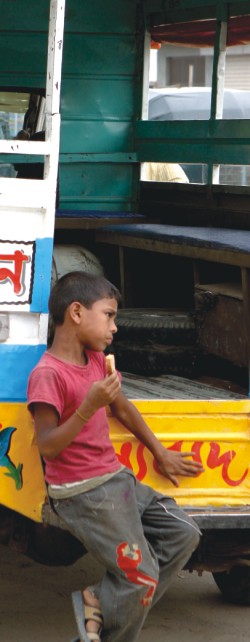 Lost Conscience
Lost Conscience

 In
In